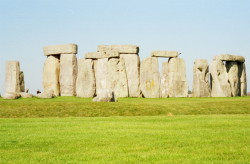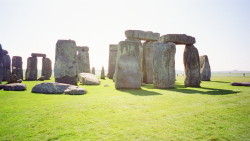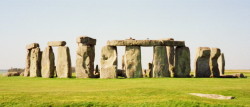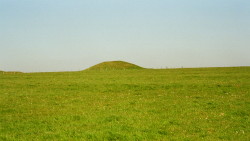
Photo. Stonehenge illuminates in the sun. © Travel Explorations.
Stonehenge is a circle by huge stones located in the middle of the barren expanse of Salisbury Plain, 1,5 hour drive from London. It is considered as the most important monument in the whole Britain. Its remains stand timeless in the middle of an English meadow. Nowhere else in the world are there similar monuments - not as well constructed as this one.
The first stone was set up here for 5000 yeas ago and the last stone was placed there 1400 years later. Take a more carefully look at the stones and the surroundings, and you will see that the mystery is even bigger than the stones themselves.
On Sunday 7 April 2002 I stood up early in the morning and took my way out to the beautiful English countryside. My target was to experience the presence of the mentioned large circular earthwork. I approached the World Heritage Site, called Stonehenge, from the Westside as the rest of the visitors, eager to take circuit.
The original ceremonial entrance was from the north-east, and the Avenue, a processional way, was later added in the same direction. Both the entrance and the Avenue align with the direction of the midsummer sunrise. According to English Heritage's guidebook, the finale stage of Stonehenge, which visitors see today, is considerably ruined.
Open door temple and observatory
I took my time around the self-guided trail around Stonehenge. It was a pretty windy day, but fortunately the sky was clear blue. The sight was just perfect. The history of this monument is from 3050 BC to 1600 BC. It`s even older than the Great Pyramid of Giza in Egypt, which was built by the Egyptian pharaoh Khufu of the Fourth Dynasty around the year 2560 BC to serve as a tomb when he dies.
In the middle of the beautiful English scenery, these stones from Stonehenge looked like an apocalypse. My first impression was that this most have a deeper meaning. Not only because of the huge stone circle, but there was more to look at.
It is easy to ignore the surroundings with such amazing construction in focus, but when I looked around I was even more convinced that all the details had a higher thought. I noticed an outer boundary formed as a circular ditch (goes around the whole stone complex). After a while I could see the whole picture. This was not actual a stone circle, but it may be a great open door temple, a sanctuary for ancient people. It could also be a kind of observatory. Based on studies, some people have theories about that Stonehenge has been constructed linked to the directions of the rising and setting of the sun.
In addition there are number of barrows (grave mounds) around Stonehenge. I started to wonder whether they had something to do with Stonehenge. They are grouped in four round types: bowl, bell, disc and pond. Sometimes burials were inserted into mounds of existing barrows. There are also flat graves between the barrows. It is believed that these barrows have been used for burial-places of the rulers at this time. The rulers were usually buried with grave goods to support them on the journey into the next world. Actual Stonehenge might be a site for several purposes.
| Photo. I enjoyed exploring Stonehenge on a very windy, but sunny morning. © Travel Explorations. |
 |
By watching these stones, my fantasy brought me long back in the past. I tried to imagine how the life was then, why they made this mystical construction, how they raised the stones and who did it. So eager I was, I took my second trip around the stone circle. I dreamed away. I could easily understand that the incredible construction has been done by a great achievement.
If these prehistoric people had such primitive means available for moving, shaping and erecting, how would it be possible for them to make it? I could not get this out of my mind for several days afterwards. It was amazing. It is possible to find a rationally answer on this, or do we have to find explanations far beyond our world?
Photo. The sarsen circle its run of continuous (horizontal) lintels, seen from the north-east.
© Travel Explorations. |
 |
The larger blocks and their lintels are all of sarsen, a natural sandstone which occurs as huge boulders on the surface of the Marlborough Downs about 30 km to the north of Stonehenge. Based on information from the English Heritage, evidence from an excavation in 1979 suggests that the Heel Stone may have been one of a pair or was part of a line of stones.
The smaller stones, known as the Bluestones from their colour (about 2 metres high), are of several kind of rock which come from the mystical Preseli Mountains in the south-west Wales, about 385 km away. How could people at this time be able to transport and erect stones weighing up to 45 tonnes and are over 7 metres high (the upright sarsen stones)? Is this construction really done by human beings? Even with modern technology and motorization today it would be quiet challenging to handle these heavy stones.
|
Photo. See in the middle: one of the five massive trilithons which were set within the sarson stone circle.
© Travel Explorations.
|
 |
The smaller stones, the bluestones, vary in sizes, but most were about 2 metres in length. Originally there were about 60 bluestones there.
| Photo. See the ditch, which goes in a circle around the stone complex (circular ditch). © Travel Explorations. |
 |
Photo. Stonehenge stands in its full pride, with clear blue sky in the background.
© Travel Explorations. |
 |
|
Photo. The Heel Stone.
© Travel Explorations.
For me it looked like an Eros symbol, but according to English Heritage this stone marks the original approach to Stonehenge.
The stone shows the direction of the midsummer sunrise when viewed from the centre.
|
 |
Photo. One of the many burial mounds close to Stonehenge. © Travel Explorations.
Is it a connection with the stone circle? |
 |
Neighbouring monuments
The landscape few kilometres around Stonehenge contains several prehistorical remains than any other area of the same size in Britain. The monuments themselves are of several different kinds, with different purposes. The names of some of the others are Woodhenge, Coneybury and Durringtion Walls, which are believed to be prehistorical temples. Explorations through time have made it possible to get a good impression of how people lived in the past.
The unique design and constructions of Stonehenge shows a number of features, which cannot be found other places, but the purpose for its function is probable the same.
This article continues in part 2. Read more (click here): Stonehenge - Part 2 .
Stein Morten Lund, 7 April 2002
Additional information
English Heritage:
English Heritage looks after over 350 historic buildings and monuments in England, most of with are open to the public. All these and more are open to free to members of English Heritage. Full details are given in the English Heritage Guide (on sale at the monuments, or free to members).
You can help English Heritage to improve public enjoyment and understanding of its property by becoming a member. In addition to free admission to all sites you will receive a regular Magazine informing you about properties and special events. Details are available at any manned monuments or, by post only, from English Heritage, PO Box 1BB, London W1A 1BB.
Local Museums nearby Stonehenge:
Visitors are advised to check hours of admission in advance before making a long journey.
Salisbury and South Wiltshire Museum:
The King's House, 65 The Close, Salisbury
SP1 2EN. Telephone: 01722 332151
Open: Monday-Saturday (and Sunday afternoons in July and August).
Items from the excavations in the Stonehenge Gallery and a special exhibit on Early Man in Wiltshire.
Devizes Museum:
The Wiltshire Archaeological and Natural History Society.
41 Long Street, Devizes SN10 1NS
Telephone: 01380 727369
Open: Tuesday-Saturday
Artefacts from the barrows and other prehistoric collections. Henge Monument Room.
Alexander Keiller Museum Avebury:
Avebury, Marlborough SN8 1RF
Telephone: 01672 539250
Open: Monday-Sunday
Flints and pottery from excavations at Avebury, Windmill Hill, Silbury Hill and West Kennet.
Facts about Stonehenge:
Stonehenge was constructed in three main phases:
3050 BC - (5050 years ago): Circular ditch and bank (a henge).
2500 BC circa - (4500 years ago): Wooden structure constructed at centre.
2500 - 1500 BC - (4500 - 3500 years ago): Stone monument constructed, arranged and rearranged over almost 1000 years.
For more information about the chronology, see book Monuments in its Landscape by Cleal, Monague and Walker (English Heritage; 1985).
The Sarsen Circle: this circle is about 30 metres in diameter. It consist originally of 30 uprights, each weighting about 25 tonnes, capped by a continuous ring of 30 lintels weighing about 7 tonnes. Inside it was a horseshoe of five Sarsen Trilithons each consisting of a pair of huge uprights, weighing up to 45 tonnes, capped by massive lintel.
Facts about Avebury stone circle:
This stone circle is located in Avebury and consists of nearly 700 megaliths weighing up to 40 tons, which were dragged here centuries ago. Thoroughly explorations have been done through the last century. Some people say that they could not have been placed there by man alone. What do you think?



















